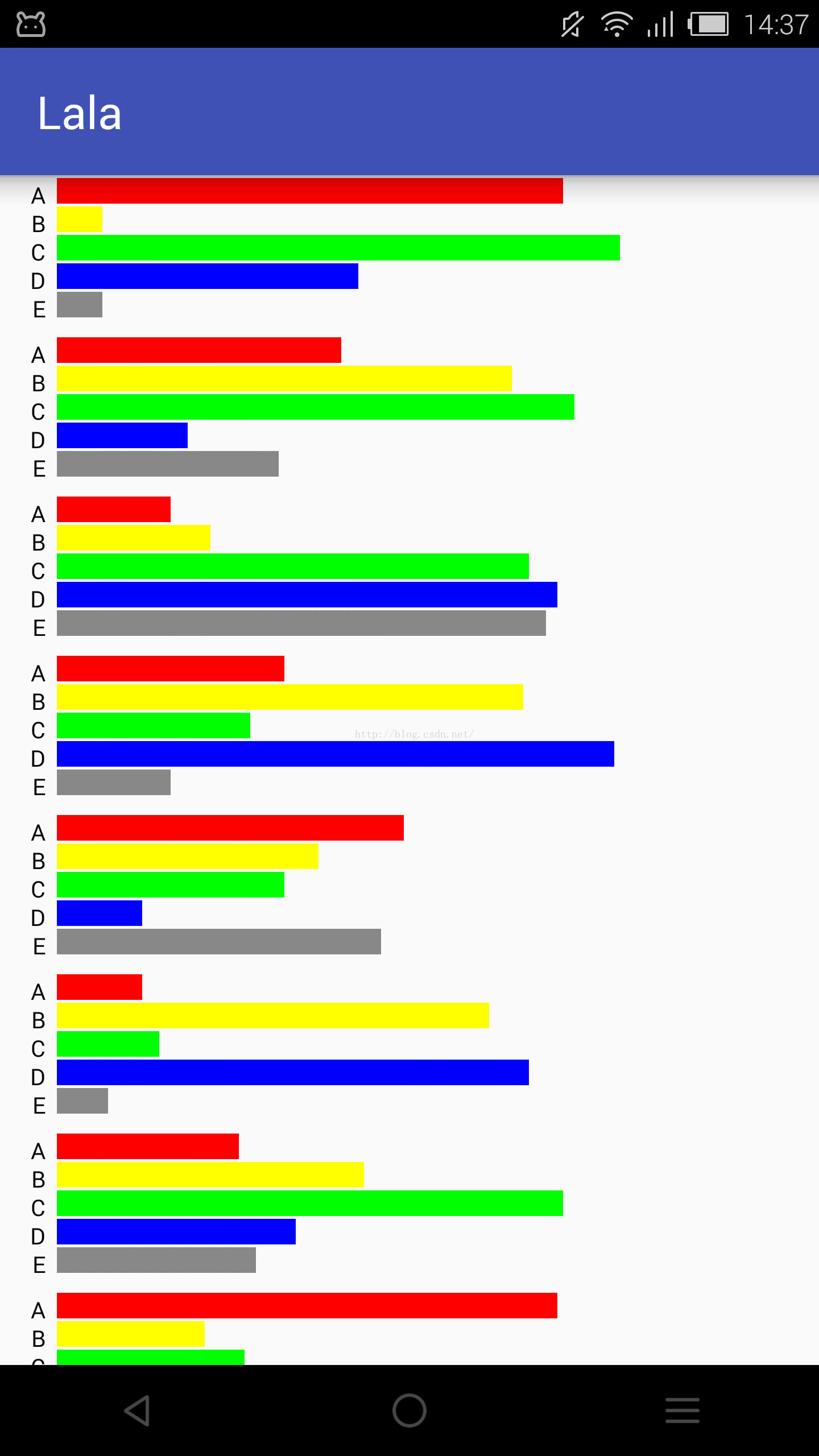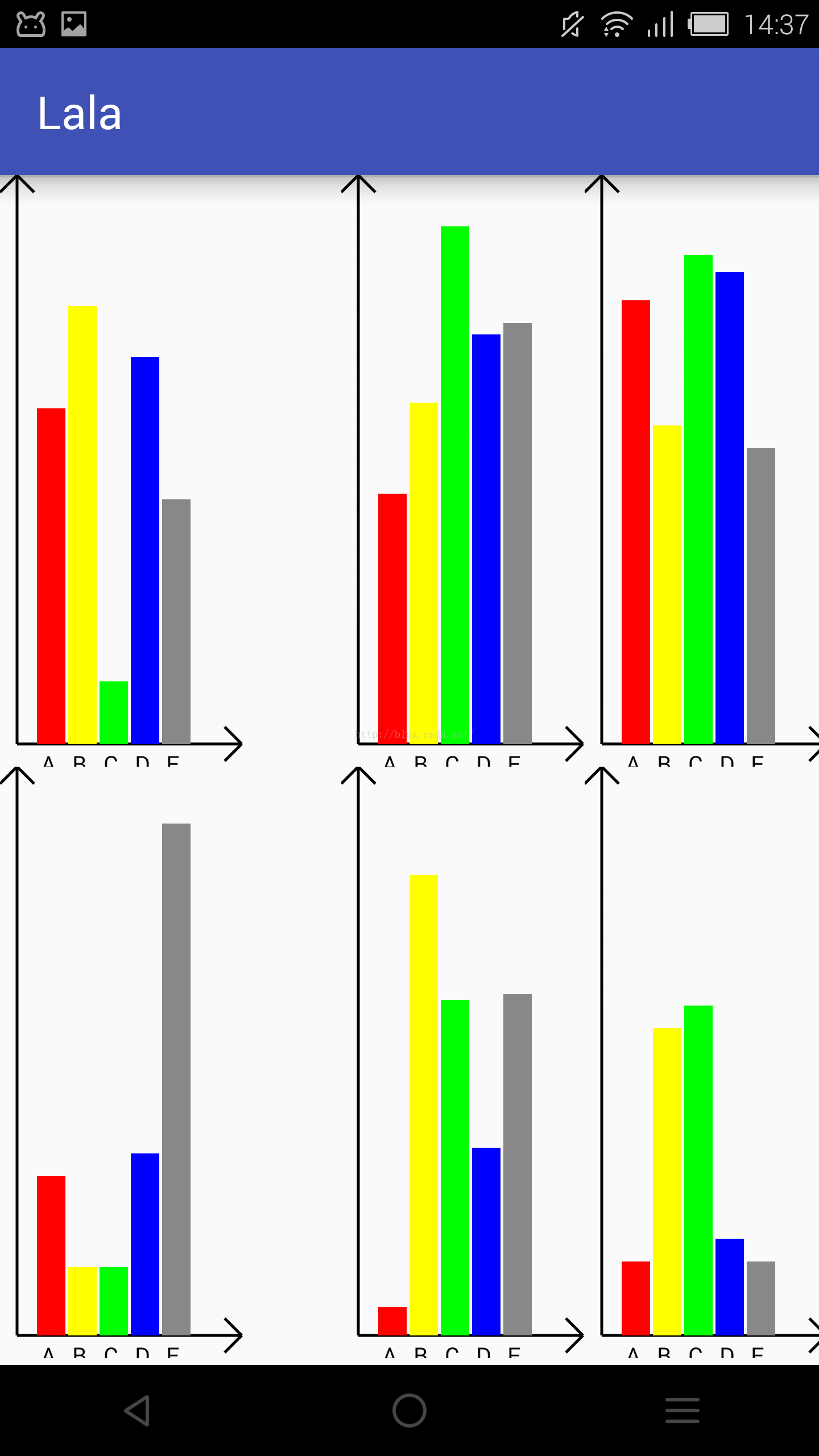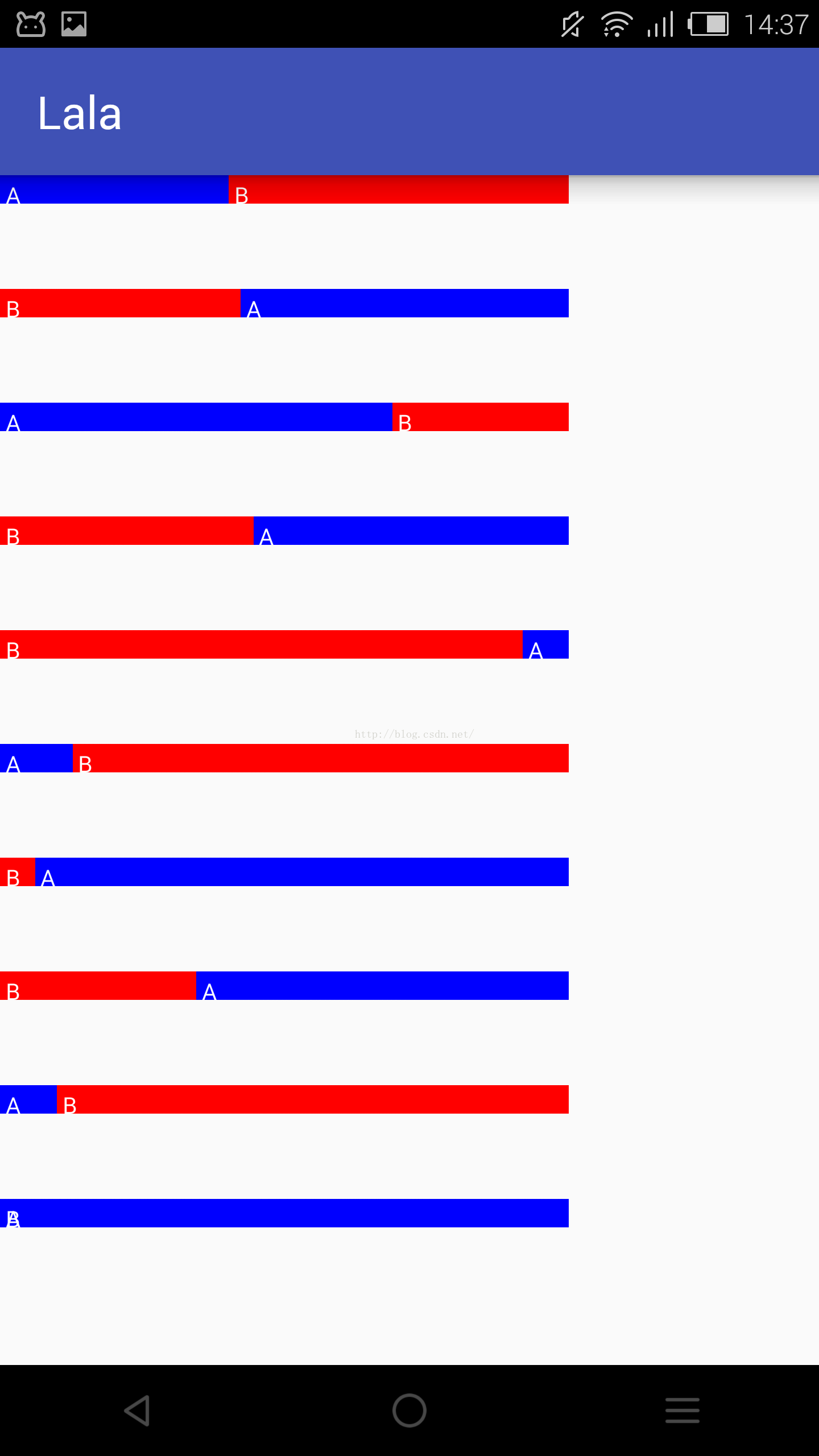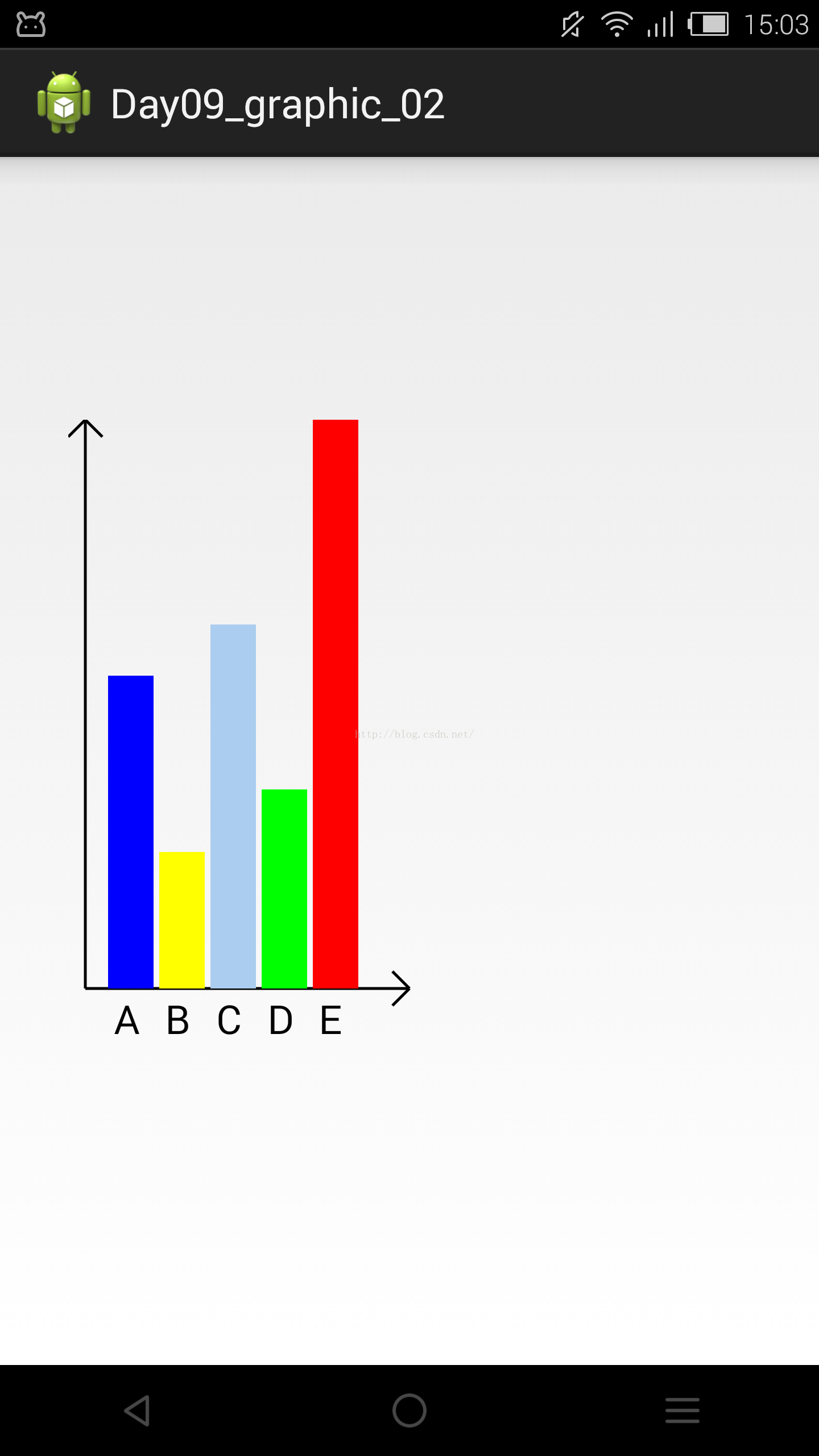編輯:關於Android編程
今天做項目需要用到簡單的橫向的柱狀圖,上網查了一下,沒找到合適的框架,於是決定自己動手寫一個自定義View,來實現三種柱狀圖。
那麼先看效果圖

橫向的柱狀圖,只有柱子的比例和文字。

縱向的柱狀圖,加上了坐標軸的繪制。

比例式柱狀圖,只接受長度為2的數組,會自己判斷將長的置於背景。
那麼我們看一下這個自定義View的代碼:
package com.example.day09;
import android.content.Context;
import android.graphics.Canvas;
import android.graphics.Color;
import android.graphics.Paint;
import android.util.AttributeSet;
import android.view.View;
import android.view.animation.Animation;
import android.view.animation.ScaleAnimation;
/**
* Created by Administrator on 2016/11/3.
*/
public class Histogram extends View {
private int[] nums;
private String[] names;
private int[] colors;
private Context context;
private int max = 0;
private int type;
private int wheretext;
private int maxlong;
private int j;
private int width;
private int kong;
private boolean useAnimation;
private Histogram v;
public void setNames(String[] names) {
this.names = names;
}
public void setMax(int max) {
this.max = max;
}
public void setType(int type) {
this.type = type;
}
public void setWheretext(int wheretext) {
this.wheretext = wheretext;
}
public void setMaxlong(int maxlong) {
this.maxlong = maxlong;
}
public void setWidth(int width) {
this.width = width;
}
public void setKong(int kong) {
this.kong = kong;
}
public void setUseAnimation(boolean useAnimation) {
this.useAnimation = useAnimation;
}
public Histogram(Context context, AttributeSet attrs, int defStyle) {
super(context, attrs, defStyle);
this.context = context;
v = this;
}
public Histogram(Context context, AttributeSet attrs) {
super(context, attrs);
this.context = context;
v = this;
}
public Histogram(Context context) {
super(context);
v = this;
this.context = context;
}
/**
* 初始化柱狀圖的方法
*
* @param nums 存放每個元素數量的數組
* @param names 存放每個元素文字的數組
* @param colors 存放每個元素使用的顏色的數組
* @param type 定義柱狀圖的類型 1為橫向,2為縱向,其余為比例
* @param wheretext 定義柱狀圖文字的位置 (若橫向)1為圖前,2為圖後,其余為無文字;(若縱向)1為圖下,其余無文字
* @param maxlong 柱狀圖的最大長度(px)
* @param max 最大長度對應的數值
* @param width 每條柱子的寬度
* @param kong 柱子之間的空隙寬度
*/
public void SetHistogram(int[] nums, String[] names, int[] colors, int type, int wheretext, int maxlong, int max, int width, int kong, boolean useAnimation) {
this.colors = colors;
this.names = names;
this.nums = nums;
this.type = type;
this.wheretext = wheretext;
this.maxlong = maxlong;
this.max = max;
j = maxlong / max;
this.width = width;
this.kong = kong;
this.useAnimation = useAnimation;
}
public void SetHistogram(int[] nums, int[] colors, int type) {
SetHistogram(nums, null, colors, type, 0, 800, 100, 50, 0, false);
}
public void SetHistogram(int[] nums, int[] colors) {
SetHistogram(nums, colors, 1);
}
@Override
protected void onDraw(Canvas canvas) {
super.onDraw(canvas);
Paint p = new Paint(Paint.ANTI_ALIAS_FLAG);
switch (type) {
case 1:
DrawHeng(canvas, p);
break;
case 2:
DrawShu(canvas, p);
break;
default:
DrawBiLi(canvas, p);
break;
}
}
/**
* 畫橫向比例柱狀圖
*
* @param canvas
* @param p
*/
private void DrawBiLi(Canvas canvas, Paint p) {
int i, j;
if (nums[0] > nums[1]) {
i = 0;
j = 1;
} else {
i = 1;
j = 0;
}
int[] numss = new int[]{nums[i], nums[j]};
int[] colorss = new int[]{colors[i], colors[j]};
String[] namess = new String[]{names[i], names[j]};
float bili = (0.0F + numss[0]) / (0.0F + numss[1]);
switch (wheretext) {
case 1:
p.setColor(colorss[0]);
canvas.drawRect(0, 0, maxlong, width, p);
p.setColor(colorss[1]);
canvas.drawRect(0, 0, maxlong / bili, width, p);
//寫字
p.setColor(Color.WHITE);
p.setTextSize(width - 10);
p.setTextAlign(Paint.Align.LEFT);
canvas.drawText(namess[0], 10, width, p);
canvas.drawText(namess[1], maxlong / bili + 10, width, p);
if (useAnimation) {
setAnimationHeng();
}
break;
default:
p.setColor(colorss[0]);
canvas.drawRect(0, 0, maxlong, width, p);
p.setColor(colorss[1]);
canvas.drawRect(0, 0, maxlong / bili, width, p);
if (useAnimation) {
setAnimationHeng();
}
break;
}
}
/**
* 畫縱向柱狀圖
*
* @param canvas
* @param p
*/
private void DrawShu(Canvas canvas, Paint p) {
switch (wheretext) {
case 1:
//畫坐標軸
p.setStrokeWidth(5);
p.setColor(Color.BLACK);
canvas.drawLine(30, maxlong, nums.length * (width + kong) + 150, maxlong, p);
canvas.drawLine(nums.length * (width + kong) + 150, maxlong, nums.length * (width + kong) + 120, maxlong - 30, p);
canvas.drawLine(nums.length * (width + kong) + 150, maxlong, nums.length * (width + kong) + 120, maxlong + 30, p);
canvas.drawLine(30, maxlong, 30, 0, p);
canvas.drawLine(30, 0, 0, 30, p);
canvas.drawLine(30, 0, 60, 30, p);
//畫柱子
for (int i = 0; i < nums.length; i++) {
p.setColor(colors[i]);
canvas.drawRect(60 + kong + (i * (kong + width)), maxlong - (j * nums[i]), 60 + kong + (i * (kong + width)) + width, maxlong, p);
p.setColor(Color.BLACK);
p.setTextSize(width - 10);
p.setTextAlign(Paint.Align.LEFT);
canvas.drawText(names[i], 60 + ((width + kong) * i) + width / 4, maxlong + width, p);
}
if (useAnimation) {
setAnimationShu();
}
break;
default:
//畫坐標軸
p.setStrokeWidth(5);
p.setColor(Color.BLACK);
canvas.drawLine(30, maxlong, nums.length * (width + kong) + 150, maxlong, p);
canvas.drawLine(nums.length * (width + kong) + 150, maxlong, nums.length * (width + kong) + 120, maxlong - 30, p);
canvas.drawLine(nums.length * (width + kong) + 150, maxlong, nums.length * (width + kong) + 120, maxlong + 30, p);
canvas.drawLine(30, maxlong, 30, 0, p);
canvas.drawLine(30, 0, 0, 30, p);
canvas.drawLine(30, 0, 60, 30, p);
//畫柱子
for (int i = 0; i < nums.length; i++) {
p.setColor(colors[i]);
canvas.drawRect(60 + kong + (i * (kong + width)), maxlong - (j * nums[i]), 60 + kong + (i * (kong + width)) + width, maxlong, p);
}
if (useAnimation) {
setAnimationShu();
}
break;
}
}
/**
* 畫橫向柱狀圖
*
* @param canvas
* @param p
*/
private void DrawHeng(Canvas canvas, Paint p) {
switch (wheretext) {
case 1:
for (int i = 0; i < nums.length; i++) {
p.setColor(Color.BLACK);
p.setTextSize(width - 10);
p.setTextAlign(Paint.Align.RIGHT);
canvas.drawText(names[i], 80, width + width * i, p);
p.setColor(colors[i]);
canvas.drawRect(100, i * width + kong, 100 + nums[i] * j, width + i * width, p);
if (useAnimation) {
setAnimationHeng();
}
}
break;
case 2:
for (int i = 0; i < nums.length; i++) {
p.setColor(colors[i]);
canvas.drawRect(0, i * width + kong, nums[i] * j, width + i * width, p);
p.setColor(Color.BLACK);
p.setTextSize(width - 10);
p.setTextAlign(Paint.Align.LEFT);
canvas.drawText(names[i], nums[i] * j + 20, width + width * i, p);
if (useAnimation) {
setAnimationHeng();
}
}
break;
default:
for (int i = 0; i < nums.length; i++) {
p.setColor(colors[i]);
canvas.drawRect(0, i * width + kong, nums[i] * j, width + i * width, p);
if (useAnimation) {
setAnimationHeng();
}
}
break;
}
}
/**
* 設置動畫(橫向)
*/
private void setAnimationHeng() {
ScaleAnimation scaleAnimation = new ScaleAnimation(0.0f, 1.0f, 1.0f, 1.0f
, Animation.RELATIVE_TO_SELF, 0.0f, Animation.RELATIVE_TO_SELF, 0.0f);
scaleAnimation.setDuration(1000);
this.setAnimation(scaleAnimation);
scaleAnimation.startNow();
}
/**
* 設置動畫(橫向)
*/
private void setAnimationShu() {
ScaleAnimation scaleAnimation = new ScaleAnimation(1.0f, 1.0f, 0.0f, 1.0f
, Animation.RELATIVE_TO_SELF, 0.0f, Animation.RELATIVE_TO_SELF, 0.0f);
scaleAnimation.setDuration(1000);
this.setAnimation(scaleAnimation);
scaleAnimation.startNow();
}
}
/**
* 初始化柱狀圖的方法
*
* @param nums 存放每個元素數量的數組
* @param names 存放每個元素文字的數組
* @param colors 存放每個元素使用的顏色的數組
* @param type 定義柱狀圖的類型 1為橫向,2為縱向,其余為比例
* @param wheretext 定義柱狀圖文字的位置 (若橫向)1為圖前,2為圖後,其余為無文字;(若縱向)1為圖下,其余無文字
* @param maxlong 柱狀圖的最大長度(px)
* @param max 最大長度對應的數值
* @param width 每條柱子的寬度
* @param kong 柱子之間的空隙寬度
*/
public void SetHistogram(int[] nums, String[] names, int[] colors, int type, int wheretext, int maxlong, int max, int width, int kong, boolean useAnimation) {
this.colors = colors;
this.names = names;
this.nums = nums;
this.type = type;
this.wheretext = wheretext;
this.maxlong = maxlong;
this.max = max;
j = maxlong / max;
this.width = width;
this.kong = kong;
this.useAnimation = useAnimation;
}
後面的代碼都是根據這個方法傳進來的參數做出相應的繪制,當然,大多數有用的屬性也單獨提供了Set方法;
接下來我們簡單的試驗一下一個縱向的柱狀圖,代碼如下:
MainActivity:
package com.example.day09;
import android.app.Activity;
import android.graphics.Color;
import android.os.Bundle;
import android.view.View;
import android.view.animation.Animation;
import android.view.animation.ScaleAnimation;
public class MainActivity extends Activity {
Histogram histogram;
int[] nums;
int[] colors;
String[] names;
@Override
protected void onCreate(Bundle savedInstanceState) {
super.onCreate(savedInstanceState);
setContentView(R.layout.activity_main);
histogram= (Histogram) findViewById(R.id.imageId);
nums=new int[]{55,24,64,35,100};
colors=new int[]{Color.BLUE,Color.YELLOW,0Xffabcdef,Color.GREEN,Color.RED};
names=new String[]{"A","B","C","D","E"};
histogram.SetHistogram(nums,names,colors,2,1,1000,100,80,10,false);
ScaleAnimation scaleAnimation = new ScaleAnimation(0.0f, 1.0f, 1.0f, 1.0f
, Animation.RELATIVE_TO_SELF, 0.0f, Animation.RELATIVE_TO_SELF, 0.0f);
scaleAnimation.setDuration(1000);
histogram.setAnimation(scaleAnimation);
scaleAnimation.startNow();
scaleAnimation.setAnimationListener(new Animation.AnimationListener() {
@Override
public void onAnimationStart(Animation animation) {
}
@Override
public void onAnimationEnd(Animation animation) {
histogram.setVisibility(View.VISIBLE);
}
@Override
public void onAnimationRepeat(Animation animation) {
}
});
}
}
這樣就做出了一個簡單的柱狀圖了,截圖效果:

 android 自定義組件隨著手指自動畫圓
android 自定義組件隨著手指自動畫圓
首先自定義一個View子類: package com.example.androidtest0.myView; import android.content.Conte
 NFC的android實現
NFC的android實現
NFC簡介:Near Field Communication 近場通信,是一種數據傳輸技術。與wifi、藍牙、紅外線等數據傳輸技術的一個主要差異就是有效距離一般不能超過4
 Android中編寫屬性動畫PropertyAnimation的進階實例
Android中編寫屬性動畫PropertyAnimation的進階實例
0、基礎回顧PropertyAnimation,屬性動畫,顧名思義就是利用對象的屬性變化形成動畫的效果。屬性動畫的類可以用Animator這個抽象類來表示,通常使用它的子
 android之屬性動畫
android之屬性動畫
屬性動畫---res/animator屬性動畫故名思議就是通過動畫的方式改變對象的屬性了,我們首先需要了解幾個屬性:Duration動畫的持續時間,默認300ms。Tim